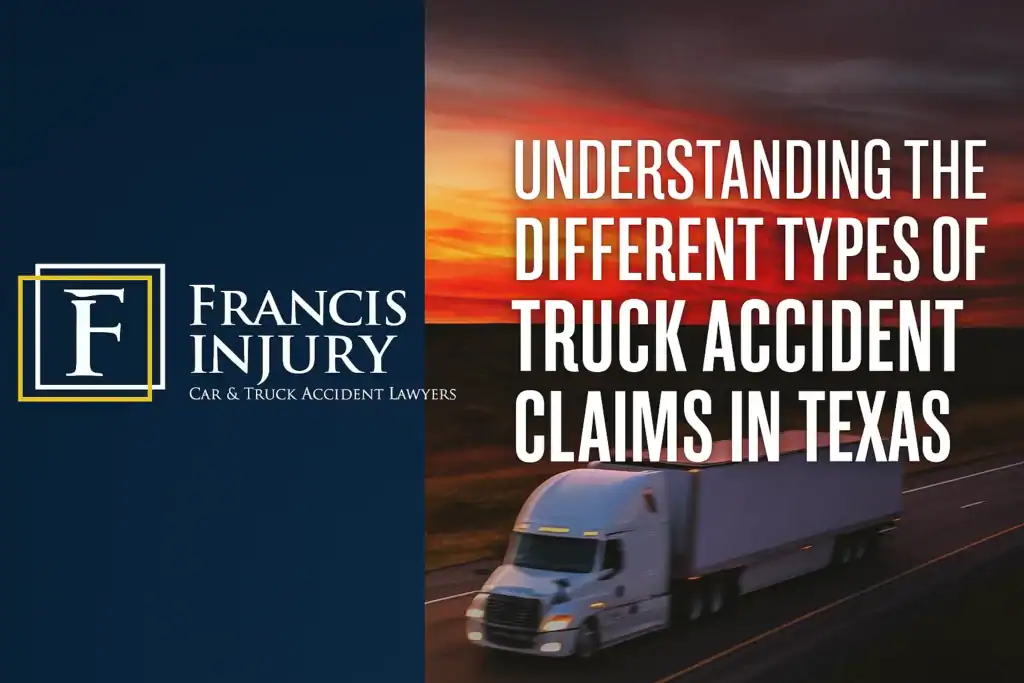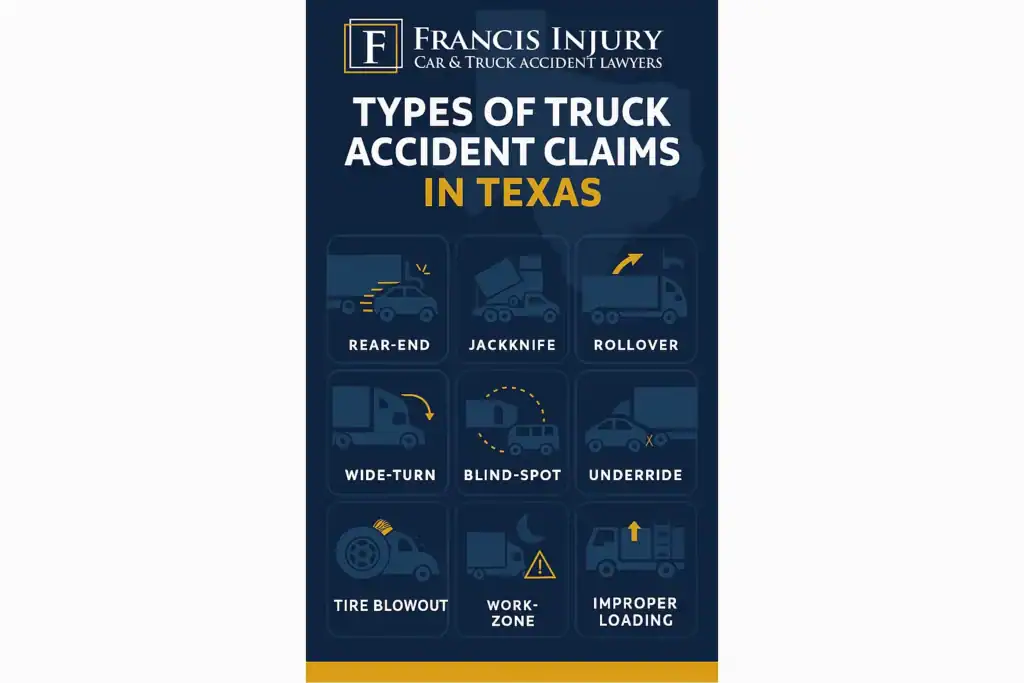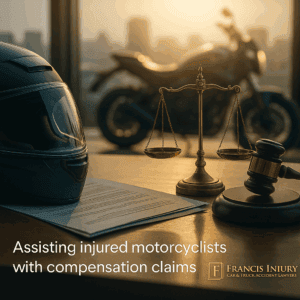Updated for 2025
If you’ve been hit by a commercial truck in Texas, your claim is not just a “big car wreck.” Truck cases involve federal and state safety rules, multiple liable parties, and serious injuries that change lives. This guide breaks down the types of truck accident claims, who can be held responsible, and what compensation is available under Texas law. For immediate help, start with a free case review at Francis Injury.

Why Truck Accident Claims Are Different in Texas
Texas applies both state and federal safety rules to commercial motor vehicles (CMVs). For example, Texas adopts DPS trucking rules in the Texas Administrative Code, Title 37, Chapter 4, and places intrastate driving‑time limits for CMV drivers under §4.12 (intrastate hours‑of‑service). Everyday driving rules also apply: Texas Transportation Code requires safe lane use and following distance (§545.062; §545.060). When a truck driver or motor carrier breaks these rules, that violation can help prove negligence.
Truck cases also involve more potential defendants (driver, employer, freight broker, shipper, maintenance contractor, parts manufacturer) and more sources of evidence (ELD hours‑of‑service logs, dashcams, ECM/“black box” data, dispatch notes, driver qualification files, repair history, and load/securement records). That’s why a Texas truck case demands a deeper investigation than a typical car crash.
Texas Truck Crash Snapshot (Placed Here for Local Authority)
Official TXDOT data shows how common CMV crashes are statewide and in the Dallas–Fort Worth area:
| Area | CMV Crashes | Fatal Crashes | Fatalities |
|---|---|---|---|
| Texas (statewide) | 38,928 | 549 | 621 |
| Dallas County | 3,871 | 38 | 44 |
| Tarrant County | 1,868 | 13 | 18 |
| Collin County | 684 | 4 | 4 |
| Denton County | 853 | 6 | 6 |
Common Types of Truck Accident Claims (Texas Examples)
Below are the most frequent claim types our Texas clients face, what typically causes them, who may be liable, and the key evidence to secure early.
- Rear‑End Collisions — Often tied to unsafe following distance, speeding, or distraction. Texas law requires an “assured clear distance” (§545.062). Internal link: learn more in our Rear‑End Collisions guide. Evidence: dashcam/ECM speed data, brake inspections, phone records.
- Jackknife Accidents — Hard braking, slick roads, improper braking technique, or overweight/poorly balanced trailers can force the trailer to swing out. See our internal piece on jackknife crashes (search “jackknife” on our site). Evidence: ELD hours, weather logs, load sheets, driver training records.
- Rollover Crashes — Common with high center‑of‑gravity and shifting cargo. Evidence: cargo securement per FMCSR/Texas adoption, scale tickets, route/curve analysis.
- Wide‑Turn & Squeeze‑Play Crashes — Right turns that swing wide and trap a car between the trailer and curb. Evidence: intersection cameras, driver training, route plans.
- Blind‑Spot (“No‑Zone”) Sideswipes — Unsafe lane changes contrary to Texas laned‑traffic rules (§545.060). Evidence: mirror setup/photos, driver line‑of‑sight diagrams, ECM lane‑change events.
- Underride/Override Collisions — Catastrophic when guards fail or are missing. Evidence: trailer guard specs/maintenance, post‑crash measurements, reconstruction.
- Tire Blowout/Brake Failure — Points toward negligent maintenance or faulty parts. Evidence: maintenance/vendor records, defect recalls, parts preservation.
- Work‑Zone & Speed‑Related Crashes — Speeding and unsafe driving in DFW work zones are frequent. Texas has special speed rules and local authority to adjust limits (§545.352; §545.356). Evidence: work‑zone plans, police lidar logs, telematics.
- Fatigue & Hours‑of‑Service — Intrastate Texas HOS rules allow up to 12 hours driving after 8 off; violations can support liability (37 TAC §4.12). Evidence: ELD/dispatch, fuel receipts, weigh‑station records.
- Improper Loading/Load Securement — Shifting or falling cargo causing loss of control or debris strikes. Evidence: bills of lading, shipper policies, photos of securement, post‑crash cargo exam.
- Hazmat & Special‑Commodity Crashes — Extra layers of training, routing, and permit rules; damages often include evacuation and cleanup costs. Evidence: hazmat endorsements, manifests, routing permits.

Who Can Be Liable (Beyond the Driver)
- Motor carrier/employer for negligent hiring, retention, training, supervision, dispatch pressure, or systemic HOS violations.
- Broker/shipper when they control safety‑critical aspects of the load, schedule, or driver selection.
- Maintenance/repair vendors for defective service leading to brake, tire, steering, or lighting failures.
- Parts manufacturers for defectively designed or manufactured components (tires, brakes, underride guards).
- Government entities for dangerous road design or missing signage when conditions meet Texas notice and immunity standards.
Texas Case Examples (Generic, For Context)
- Rural fatigue crash: An 18‑wheeler drifted across the centerline near Waco before dawn. Post‑crash ELD data showed HOS violations. The case resolved after depositions confirmed dispatch pressure to deliver overnight.
- DFW work‑zone rear‑end: A tractor‑trailer struck a slowing SUV in a construction lane on I‑35W. ECM data showed 68 mph entering an orange‑barrel taper. Settlement reflected permanent spine injuries and future wage loss.
- Improper securement rollover: A flatbed’s unbalanced steel coils shifted on a ramp, causing a rollover. Load plans and photos revealed missing/under‑rated binders; the shipper and motor carrier shared liability.
Damages Available in a Texas Truck Accident Claim
- Economic losses: emergency care, surgery, therapy, prescriptions, medical devices, home/vehicle modifications, property loss, lost wages, reduced earning capacity, and out‑of‑pocket expenses (mileage, childcare, etc.).
- Non‑economic losses: physical pain, mental anguish, physical impairment, disfigurement, and loss of enjoyment of life.
- Wrongful death/survival: funeral expenses, loss of companionship, mental anguish of family members, loss of household services, and the estate’s survival claims.
- Punitive damages: available in egregious cases (e.g., intoxication, falsified logs, knowingly unsafe equipment) subject to Texas caps and proof standards.
How Claim Type Shapes the Investigation (and Your Payout)
Every crash type directs the evidence hunt. Rear‑ends and work‑zone cases turn on speed and distance; jackknifes hinge on braking technique and load weight; rollovers point to route geometry, cargo securement, and truck maintenance. Early preservation letters should demand ELD/ECM data, driver qualification files, maintenance logs, dashcam footage, and shipper/broker communications. If the carrier has a quick‑response team on scene, you need one too—fast.
Step‑by‑Step: The Texas Truck Accident Claim Process
- 1) Call 911 and get medical care. Tell providers about every area of pain. Follow up.
- 2) Capture evidence now. Photos/video of vehicles, lanes, skid marks, debris, signage, and work‑zone layouts. Gather witness info.
- 3) Report and document. Request the Texas Peace Officer’s Crash Report (CR‑3). See TXDOT’s crash data resources here.
- 4) Hire counsel quickly. Your lawyer should send spoliation letters within days and secure the truck for inspection.
- 5) Liability & damages build‑out. Pull ELD/ECM, dispatch, and training files; order full medicals; compute wage loss and future care.
- 6) Negotiate or litigate. Many cases resolve after depositions and expert reports. Others require trial.
FAQs: Quick Wins You Should Know
- Texas HOS rules for intrastate drivers? Up to 12 hours driving within a 15‑hour on‑duty window after 8 hours off (37 TAC §4.12).
- What if I was partly at fault? Texas uses proportionate responsibility—your compensation drops by your percentage of fault, and is barred if you’re 51%+ at fault.
- Time limit to file? Generally two years from the crash for personal injury; shorter deadlines may apply for certain government claims. Speak with counsel immediately.
How long do I have to file a Texas truck accident claim?
What if the trucking company blames me?
Are intrastate hour‑of‑service rules different in Texas?
What evidence should I save after a crash?
Visit Our Fort Worth Office
640 Taylor St, Suite 1200B, Fort Worth, TX 76102
- Assisting injured motorcyclists with compensation claims

- The Impact of Vehicle Safety Features on Dallas Car Accident Claims

- When to Hire a Personal Injury Lawyer After a Minor Accident

- What to Do After a Motorcycle Accident

- Can I Sue Lyft After an Accident?

- Why Do You Need a Personal Injury Lawyer?

Injured in a Texas truck crash? Don’t let the carrier’s team control the narrative. Get your Free Case Review or call (817) 329‑9001 now.

